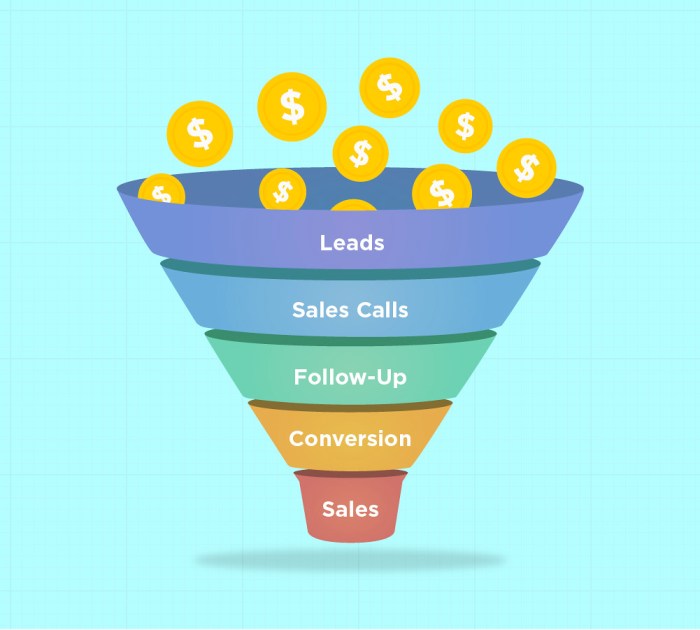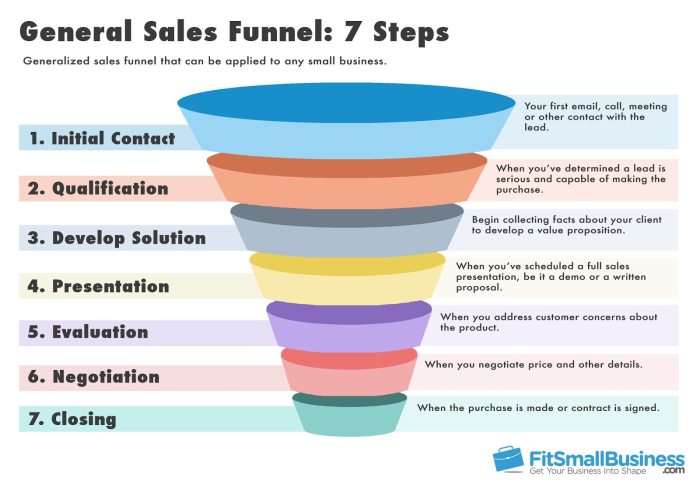Understanding Sales Funnels is like navigating a roadmap to success in the marketing world. From lead generation to customer conversion, this concept is crucial for businesses aiming to thrive in the competitive market.
Dive deeper into the realm of sales funnels to uncover the secrets of driving sales and expanding your customer base.
Introduction to Sales Funnels

In the world of marketing, a sales funnel is a crucial concept that Artikels the journey a potential customer takes from being aware of a product or service to making a purchase. It helps businesses understand and optimize the process of converting leads into customers efficiently.
Stages in a Typical Sales Funnel, Understanding Sales Funnels
- 1. Awareness: This is the stage where the customer becomes aware of the product or service, usually through marketing efforts like ads, social media, or content.
- 2. Interest: Once aware, the customer shows interest in the product or service by researching or engaging with the brand further.
- 3. Decision: In this stage, the customer evaluates the options and decides whether or not to make a purchase.
- 4. Action: The final stage where the customer takes action and makes a purchase, becoming a customer.
Significance of Sales Funnels
Sales funnels are essential for businesses as they provide a structured approach to lead conversion. By guiding customers through each stage, businesses can tailor their marketing strategies and optimize their sales process to increase conversions. Understanding the different stages of a sales funnel allows businesses to identify areas for improvement and enhance customer engagement throughout the journey.
Types of Sales Funnels: Understanding Sales Funnels
When it comes to sales funnels, there are various types that cater to different business goals and strategies. Let’s dive into the different types of sales funnels and how they can benefit your business.
Lead Generation Funnels
Lead generation funnels are designed to attract potential customers and capture their contact information. These funnels typically offer valuable content or incentives in exchange for a visitor’s email address or other contact details. Once leads are captured, businesses can nurture them through email marketing campaigns to eventually convert them into paying customers.
Webinar Funnels
Webinar funnels are used to promote and sell products or services through live or pre-recorded webinars. These funnels typically involve inviting prospects to a free webinar where they can learn more about a product or service before being presented with an offer to purchase. Webinars are an effective way to educate prospects and build trust before making a sales pitch.
Product Launch Funnels
Product launch funnels are specifically designed to generate buzz and excitement around a new product or service. These funnels often involve a series of pre-launch content, such as videos, emails, or social media posts, to build anticipation among potential customers. The goal is to create a sense of urgency and encourage prospects to purchase during the launch period.
Short vs. Long Sales Funnels
Short sales funnels are designed to quickly convert leads into customers by guiding them through a few simple steps, such as opting in for a free trial or making a low-cost purchase. On the other hand, long sales funnels involve multiple touchpoints and nurturing sequences to build trust and relationships with prospects before making a sale. Long sales funnels are often used for high-ticket products or services that require more consideration from the buyer.
Catering to Different Business Goals
Each type of sales funnel caters to different business goals and objectives. Lead generation funnels are ideal for businesses looking to grow their email list and generate leads, while webinar funnels are great for promoting and selling products through educational content. Product launch funnels are perfect for creating excitement around new offerings and driving sales during a launch period. Whether you’re focusing on lead generation, sales conversions, or brand awareness, there’s a sales funnel type that can help you achieve your specific business goals.
Creating an Effective Sales Funnel
When it comes to designing a high-converting sales funnel, there are a few best practices that can make a big difference. Understanding your target audience is key, as it allows you to tailor your funnel to meet their specific needs and preferences. Optimizing each stage of the funnel is also crucial for maximizing results and driving conversions.
Designing a High-Converting Sales Funnel
To create an effective sales funnel that converts leads into customers, it’s important to follow these best practices:
- Start with a compelling offer: Your funnel should begin with a strong value proposition that captures the attention of your target audience.
- Build trust with your audience: Use testimonials, case studies, and social proof to establish credibility and trust with potential customers.
- Optimize for mobile: With more people browsing and shopping on mobile devices, it’s essential to ensure your funnel is mobile-friendly for a seamless user experience.
Understanding the Target Audience
When creating a sales funnel, it’s crucial to have a deep understanding of your target audience. This knowledge allows you to:
- Create personalized messaging: Tailor your content to resonate with the specific needs and pain points of your audience.
- Identify the right channels: Knowing where your audience spends their time online helps you reach them effectively through the right channels.
- Address objections: Anticipate and address any concerns or objections your audience may have throughout the funnel to increase conversion rates.
Optimizing Each Stage of the Sales Funnel
To maximize results and drive conversions, it’s important to optimize each stage of your sales funnel:
- Awareness stage: Focus on creating awareness and capturing the attention of your target audience through engaging content and eye-catching visuals.
- Interest stage: Provide valuable information and solutions to pique the interest of potential customers and keep them engaged.
- Decision stage: Make it easy for customers to make a purchase decision by offering clear pricing, product details, and a smooth checkout process.
- Action stage: Encourage customers to take action by including compelling calls-to-action and creating a sense of urgency to drive conversions.
Sales Funnel Metrics and Tracking

In the world of sales funnels, understanding key metrics and tracking performance is crucial for optimizing your marketing efforts and maximizing conversions. By monitoring metrics such as conversion rates, bounce rates, and customer acquisition cost, businesses can gain valuable insights into the effectiveness of their sales funnels.
Key Metrics to Track
- Conversion Rates: This metric measures the percentage of visitors who take a desired action, such as making a purchase or signing up for a newsletter. Tracking conversion rates helps businesses identify areas for improvement in their sales funnel.
- Bounce Rates: Bounce rate indicates the percentage of visitors who navigate away from a website after viewing only one page. A high bounce rate could signal issues with the landing page or overall user experience.
- Customer Acquisition Cost (CAC): CAC calculates the total cost of acquiring a new customer, including marketing and sales expenses. Monitoring CAC is essential for determining the return on investment for each customer acquired.
Tools for Tracking and Analyzing Performance
- Google Analytics: A popular tool for tracking website traffic, user behavior, and conversions. Businesses can set up goals and funnels to monitor the effectiveness of their sales funnel.
- CRM Software: Customer Relationship Management software allows businesses to track interactions with leads and customers throughout the sales funnel. This data can provide valuable insights into customer behavior and preferences.
- A/B Testing Tools: Tools like Optimizely or VWO enable businesses to test different variations of their sales funnel to see which performs best. This data-driven approach can lead to improved conversion rates.
Interpreting Data for Informed Decisions
- Identify Bottlenecks: Analyze the data to pinpoint areas in the sales funnel where visitors are dropping off or not converting. This information can help businesses make targeted improvements to increase conversions.
- Segmentation Analysis: Break down the data by different customer segments or demographics to understand which groups are responding best to the sales funnel. This insight can guide personalized marketing strategies.
- ROI Calculation: Evaluate the return on investment for each stage of the sales funnel to determine the most cost-effective strategies. By tracking and analyzing metrics, businesses can make data-driven decisions to optimize their sales funnel.
